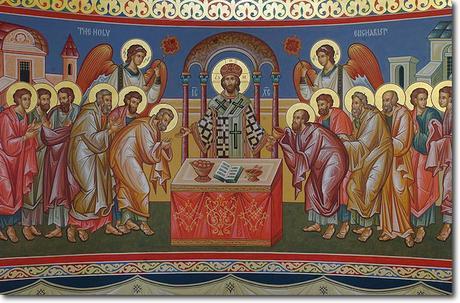
by TIMOTHY D. LUSCH
Years ago, as a twenty something trying to figure out what I was doing and where I was going-as if life was a place I had to get to and a box to check off-I remember being irked by St. Paul's command to "pray without ceasing." I thought, well, that's a fine thing to say after you get knocked on your posterior and blinded by God. If I had a run-in with the Ancient One like Paul did I sure as heck would be praying without ceasing too. For the rest of us I was pretty sure it wasn't going to happen. But it bothered me. I knew Paul was no fool. Why did he say this?
I was raised Catholic, went to Catholic schools, knew my prayers. How could I say them non-stop and still go to work and school without whispering about like a mad man? Some time later, and not by chance, I stumbled upon The Way of the Pilgrim at a used book sale. As I flipped through its pages, I imagined St. Paul sniggering at me in his heavenly haven. The book is a work of Eastern Christian mysticism that, you guessed it, deals precisely with the question of how to pray without ceasing. It's called the Jesus Prayer. I felt like I'd been had.
What is the Jesus Prayer?
Also known as the Prayer of the Heart, the Jesus Prayer is believed to have originated in the sixth century. Diadochos, perhaps the earliest known practitioner of the prayer, taught that a person can arrive at inner stillness through its repetition. Even earlier, among ascetics in Nitria and other desert areas, a short prayer known as an "arrow prayer" was common. This type of short prayer, repeated throughout the day, formed a core part of the spiritual practice of the early monks and hermits. Coupled with silence it led the monk into a stillness that aided contemplation and offered protection from demons. But this is no prayer for old
The Jesus Prayer: An Eastern Prayer for Western Hearts http://catholicexchange.com/jesus-prayer-eastern-prayer-western-hearts
monks. It is a prayer that lives and breathes in all who say it.
How do you pray it?
To bead or not to bead, that is the question. Not really. Many who pray the Jesus Prayer opt to use beads or prayer ropes (known as chotki to Eastern Christians). Similar to a rosary or Pater Noster cord, it is used to focus one's attention in a tangible way in order to free the mind for prayer and contemplation. While they may be helpful, beads and cords are unnecessary since the Jesus Prayer is about repetition, not completion. Not a mindless repetition, but a mindful one. The basic formula is: Lord Jesus Christ, Son of God, have mercy on me, a sinner. There are many variations. For example, we can simply repeat the name of Jesus, or say Lord Jesus Christ, have mercy on me. There is no right or wrong way to say it provided the repetition is meaningful and comes from the heart in order to draw the mind to God. Orthodox Bishop Kallistos Ware believes that when praying the Jesus Prayer in fifteen minute increments we are able to conform our breathing to our praying. So, on our inhale we say, Lord Jesus Christ, Son of God. And on exhale we say have mercy on me, a sinner. This way, by the act of breathing we are praying. It can also be prayed informally throughout the day. In traffic, a long line, or in distress we can repeat the Jesus Prayer. It is a great way to sacralize the sameness of our everyday.
Why should we pray it?
The Jesus Prayer is a simple way to bring us into unceasing contact with Jesus in unity with our Eastern Christian brothers and sisters. As Christians we are about devotion not division. The recent meeting of Pope Francis and Russian Orthodox Patriarch Kirill in Cuba is proof of the treasure at the heart of Christian unity. The richness of the Jesus Prayer deepens our prayer life by simplifying it. As a person who likes to complicate things to the point of not doing them (prayer is no exception), the simplicity of the Jesus Prayer unties all my knots and defeats my excuses. It helps me focus on spiritual progress, not perfection. No books, no beads, no bother. The Jesus Prayer is the anytime, anywhere prayer.
Some Suggestions:
Get real. The Jesus Prayer is simple to say but can be difficult to practice. You have to make time for it in your day. Make room for it in your daily life and it will give life to your day.
Get a rhythm. Start by setting aside time to pray as Bishop Ware suggests. You will experience the natural association of breathing and praying. Setting aside time will allow the debris of daily life to dissipate in the repetition. After you are comfortable with the prayer, you can extend it throughout your day.
Get rolling. Start now. Seriously. Pray it at home, on the commute, or when dropping the kids off at school, or in a meeting. There are slices of seconds in every day that, if mindful, we can pray the Jesus Prayer. No humble mumbling is wasted. God takes what we give and returns a hundredfold.
About the Author
Timothy D. Lusch is an attorney and writer. His work has appeared in St. Austin Review, Crisis, New Oxford Review, and New English Review. He blogs at www.pityitspithy.com.
This article originally appeared on the website, CatholicExchange.
Categories Tags Catholic Religion, Bishop Ware, Cuba, Eastern Christian, Jesus Prayer, Lord Jesus Christ, LUSCH, New Oxford Review, Orthodox Bishop Kallistos WareChurch History, Prayer

